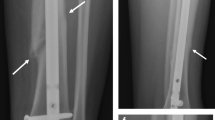Abstract
The reported work is a part of an ongoing research program concerned with structural analysis of fractured long bone and methods of internal fixation. The stress-concentration factors for equine metacarpus bones containing greenstick fractures and “through” fractures (surgically repaired) were determined for the compression, flexural and torsional modes of loading based on whole bone (unfractured) strengths. The greenstick type of fracture was simulated with saw cuts at the mid-span of the bone, and the parameters varied were depth of fracture and orientation of fracture. All specimens consisted of fresh dead bone which had been placed in a freezer within 4 hr after expiration. The maximum stress-concentration factors for the simulated greenstick fractures studied were about 3.4 for compression, 4.3 for torsion and 16 for flexure. The stressconcentration factors for fractured bones surgically repaired with commercial plates were about 3.0 for compression, 2.7 for torsion and 6.1 for flexure.
Similar content being viewed by others
Abbreviations
- A :
-
cross-sectional area of bone at midlength, in
- a 1,a 2 :
-
major radius of outer and inner ellipse, respectively, in
- b 1,b 2 :
-
minor radius of outer and inner ellipse, respectively, in
- c :
-
distance from neutral axis to outer fiber, flexure, in
- d 1,d 2 :
-
eccentricity of minor ellipse fromx andy axis, respectively, in
- k 1,k 2 :
-
aspect ratios for outer and inner ellipse, respectively, numeric
- \(\bar k\) :
-
average aspect ratio of outer and inner ellipses, numeric
- e :
-
distance from support to fracture tip, in
- F u ,F g ,F p :
-
ultimate force in flexure for unfractured bone, greenstick fracture and plated bone, respectively, kip
- GL :
-
gage length, in
- I xn8 ,I yn8 :
-
area moment of inertia aboutx neutral axis andy neutral axis, respectively, in
- L :
-
total length of bone, in
- LF :
-
load factor, percent
- MR u ,MR g ,MR p :
-
modulus of rupture for unfractured bone, greenstick fracture and plated bone, respectively, ksi
- P u ,P g ,P p :
-
ultimate force in compression for unfractured bone, greenstick fracture and plated bone, respectively, kip
- R :
-
fracture ratio,s/2b 1, percent
- SCF :
-
stress-concentration factor, numeric
- s :
-
crack depth, in
- T u ,T g ,T p :
-
ultimate torque for unfractured bone, greenstick fracture and plated bone, respectively, kip
- TR u ,TR g ,TR p `:
-
torsional modulus for unfractured, greenstick fracture and plated bone, respectively, ksi
- \(\bar x, \bar y\) :
-
distance fromy andx axis, respectively, of major ellipse to neutral surface, in
- ϕ:
-
angle of fracture, deg
- σ u , σ o , σ p :
-
ultimate strength in compression for unfractured bone and plated bone, respectively, ksi
References
Boyd, C. L., Bynum, D., Jr., Ledbetter, W. B. and Ray, D. R., “Capacity of Installed Commercial Bone Fixation Plates,” an unpublished report.
Bynum, D., Jr., Ledbetter, W. B., Boyd, C. L. and Ray, D. R., “Compression Properties of Equine Third Metacarpal Bone,” presented to Soc. of Engr. Sci. (November 1969).
Bynum, D., Jr., Ledbetter, W. B., Boyd, C. L. and Ray, D. R., “Torsional Properties of Equine Metacarpus,” an unpublished report.
Bynum, D., Jr., Ledbetter, W. B., Boyd, C. L. and Ray, D. R., “Flexural Properties of Equine Metacarpus,” an unpublished report.
Devas, M. B., “Compression Stress Fractures in Man and the Greyhound,” JBJS,43B, (1961).
Bird, F., Becker, H., Healer, J. andMesser, M., “Experimental Determination of the Mechanical Properties of Bone,”Aerospace Med.,39,44–48 (January 1968).
McElhaney, J. H. and Byars, E. F., “Strain Rate Sensitivity of Certain Biological Materials,” Rep. No. CR 62440, NASA.
Curry, G. J. andPine, D. K., “Deficiencies of Stainless Steel Internal Fixation Units,”Amer. Jnl. Surg.,95 (4),518–522 (1958).
Caden, J. G., “Internal Fixation of Fractures of the Forearm,”JBJS,43A,1115 (1961).
Dempster, W. T., Sherr, L. A. and Priest, J. G., “Conversion Scales for Estimating Humeral and Femoral Lengths and the Lengths of Functional Segments in the Limbs of American Caucasoid Males,” Human Biology, {vn36} ({sn3}) (September {dy1964}).
Evans, F. G., “Biomechanics: Stress-Strain Phenomena in Bones,” Medical Physics, O. Glassner, ed., Year Book Publ., 89–93 (1960).
Contini, R., and Drillis, R., “Biomechanics,” Applied Mechanics Surveys, H. N. Abramson, et al, ed., Spartan Books, 161–172 (1966).
Timoshenko, S. P. and Goodier, J. N., Theory of Elasticity, 3rd Ed., McGraw-Hill (1970).
Author information
Authors and Affiliations
Rights and permissions
About this article
Cite this article
Bynum, D., Ledbetter, W.B., Boyd, C.L. et al. Parametric stress-concentration factors in greenstick bone fracture. Experimental Mechanics 10, 474–480 (1970). https://doi.org/10.1007/BF02327675
Issue Date:
DOI: https://doi.org/10.1007/BF02327675




